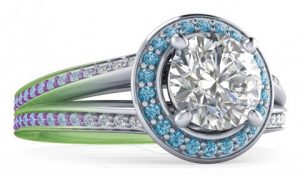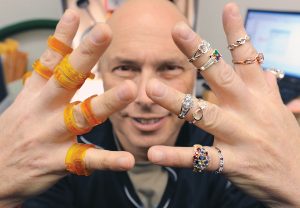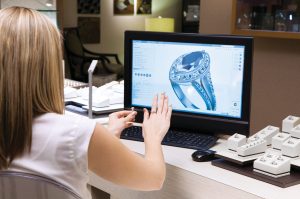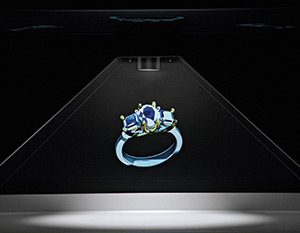
Everything you need to know about how technology can help you sell more wedding jewelry

The popularity of immersive technology like virtual reality headsets and augmented reality mobile games is a clear indication that the next wave of high-tech experiences is no longer in some far-off, sci-fi future—it’s here and now. For jewelers, the constant pace of technological change can be challenging, but marketing experts and savvy retailers say it also offers an unparalleled chance to connect with today’s bridal jewelry shopper.
“We really have to make sure that, as an industry, we’re looking at what the macro trends are in the retail experience and how they apply to jewelry,” says Katie Smith, executive director of sales development at Lafayette, La.–based Stuller. Millennial consumers’ affinity for customizing everything they do and buy is having a big impact on how retailers market and sell bridal jewelry, and on the technology it takes to do so.
“This notion of the millennial bride has changed the game in terms of how we market to them and how we sell to them,” says Kristin Suppelsa, vice president of marketing for Hearts On Fire in Boston. “They want experiences. They want to create experiences, and they’re demanding to have a better experience than picking a ring out of the case.”
Practically speaking, that means customers want a hand in selecting the details of their ring. Savvy jewelers today know they need to accommodate that demand through every step of the transaction, from time spent browsing online to the moment the shopper enters the store.
If the idea of “custom” sounds scary, here’s a little secret from marketing pros: Much of what a consumer will consider custom is really more of a mix-and-match selection process, such as choosing the metal, the size, and the shape of the center stone and deciding whether to use a halo, prong, or bezel setting.
Screen Time
Offering customers multiple views of the product is key, Suppelsa says. It’s important to give them “the opportunity to see it on a hand, to bring the product off the page and help them understand what it could look like in real life,” she says.
Build-a-ring modules are one way retailers can make the online ring–shopping experience participatory as well as personalized. “As far as our -experience goes, as high as 90 percent of sales in a jewelry e-commerce site are through the build-a-ring tool, and only 10 percent with off-the-shelf, ready-to-buy jewelry,” says Prashant Telang, founder and executive director of TransPacific Software, a Mumbai, India–based e-commerce solutions provider. “Most buyers require a unique, bespoke ring combination to suit their taste.”
Giving clients a stake in what they’re making is essential. “To have that ability to modify settings and choose what the diamond looks like is a great way to engage with the engagement ring consumer,” says Shane O’Neill, vice president at Fruchtman Marketing in Toledo, Ohio.
Walters & Hogsett, a fine jeweler in Boulder, Colo., is reviewing its e-commerce strategy in 2017 to focus more on helping shoppers browse and buy online. “We understand that 95 percent of their shopping starts online, so we want to be relevant, but we do want to get them in the store,” says president Mark Vieregg. “It’s up to an individual retailer to decide if they want to let a shopper complete a purchase online or if that remains an offline transaction. Some prefer to give them the tools to customize and view rings in 360-degree photos, but stop short of the actual purchase.”
If you’re worried about losing sales, don’t be: Jewelers say that once a customer has invested the time and emotional energy into picking out all the details of her ring, she’ll remain committed.
“I don’t think we’ve had people walk away after designing anything bridal,” Vieregg says. “Once they’ve engaged that way and see the value, they’ll generally go all the way through the process.”

Jewlr.com CEO Tony Davis models 3-D–printed wax and finished rings. (photo: Vince Talotta/Toronto Star via Getty Images)
The Software, Why, and How
In the store, CAD programs let you turn a customer’s disparate ideas into a single, meaningful piece of jewelry. “I see custom design and CAD really growing quickly,” says Matthew Perosi, founder of the Totowa, N.J.–based Jewelry Website Advisory Group.
Software like Stuller’s CounterSketch gives a jeweler wide latitude to help bridal customers choose all of the details that appeal to them, then create a virtual image. As a result, an iPad or other tablet is perhaps the most indispensable 21st-century sales tool a retailer can have for engaging with the millennial ring shopper.
“Pull up CounterSketch, and you can quickly and visually—with your customer right there—show them what all of those design options would look like on the screen,” Smith says. And you can easily make tweaks in real time to help an indecisive shopper.
“Custom work is a big part of what we do,” says Mo Jooma, president of Icebox Diamonds & Watches in Atlanta. “We have four designers on staff, so the merchandise in the showroom all has a story. We really invest a ton in technology.”
Jooma says the Icebox designers use CounterSketch as well as Gemvision’s Matrix program. “It allows us to do anything under the sun,” he says, adding that its capabilities are especially useful for catering to bridal customers who crave a truly one-of-a-kind creation.
“We don’t build anything the same,” says Lonnie McCoy, owner and president of The Jewelers Bench in Sherman, Texas. “A lot of girls have a preconceived ring in their head. To see it made in front of their eyes is very exciting, and that excitement helps build the product.”
If an iPad screen isn’t big enough for your customer’s ideas, consider what McCoy has done to display these custom creations. “I bought a 46-inch flat screen, so that is our monitor. They can see it, it’s very close, about 4 or 5 feet from where they sit,” he says. (Everything is bigger in Texas, after all.)

Stuller’s CounterSketch Bridal displays a custom ring-in-progress from every angle.
Going Offline
Being able to show a bridal customer a ring on a screen (small or large) is great, but cutting-edge retailers like Jooma say that’s just the beginning of how they use technology to bring a bridal jewelry idea to life. Icebox creates a 3-D rendering so the customer can see all the sides and angles of what the piece will look like, and creates a model using a 3-D printer. “We have two 3-D printers in-house. They run pretty much 24 hours a day,” Jooma says.
As compelling as a 3-D rendering of a unique engagement ring is, something customers can hold in their hand is even better. “Anybody who’s thinking custom design is going to save their future with CAD, they need to jump into the 3-D printer market,” Perosi says.
Stuller’s Smith agrees, saying that the effect of being able to feel, touch, and try on a model of a ring the shopper created can’t be overstated. “That ring they just designed on a screen—you can tell them, try on this resin version,” she says. “Drop a diamond in the center and she can put it on her finger. It makes for a very tactile, participatory sale.”
Ultimately, technology provides the tools, but jewelers say it’s the human touch that brings in sales and repeat customers. “We’ve got iPads, digital screens showing customization tools, and CounterSketch,” Vieregg says. “We’re definitely trying to be more tactile with them.”
But don’t discount the enduring value of person-to-person interaction, he says. “I still see many customers that want to be sold with a human standing there.”
Future Shock
“If you think the market has changed in the past five years, wait until you see the next five,” says Shane O’Neill of Fruchtman Marketing. Consider these ideas, experiments, and prototypes.

• Holographic reality: Jewelers Mutual Insurance Co. and Excelion Partners’ 3-D holographic projection prototype Holojem (pictured) won the JCK Think Tank contest at the 2016 JCK Las Vegas show.
• Metal printing: Most 3-D printers today use some kind of plastic, but the next step is creating custom ring models out of actual metal. Experts say it’s just a matter of making them accessible and affordable to retailers.
• Image searching: Imagine a kind of a search engine where you just aim your camera at a ring, or even a picture of a ring, and the program combs the internet to find it for you.
• Virtual try-ons: Another potentially exciting use for a smartphone camera involves letting the customer virtually “try on” a ring via an augmented reality app that blends the real-life and digital (think of Pokémon Go, but with bridal jewelry instead of cartoon critters).
• Full-scale virtual reality: O’Neill would not be surprised, he says, by a virtual showroom: “You put on your VR headset and access a jeweler’s app and walk into the jeweler’s store.” —MCW
Top: Stuller’s CounterSketch allows customers to combine elements from various rings into their own custom designs; inset: with Stuller’s Matrix CAD software, jewelers can create 3-D wireframe structures of custom pieces, then use those to develop full 3-D renderings.